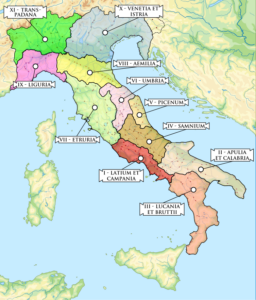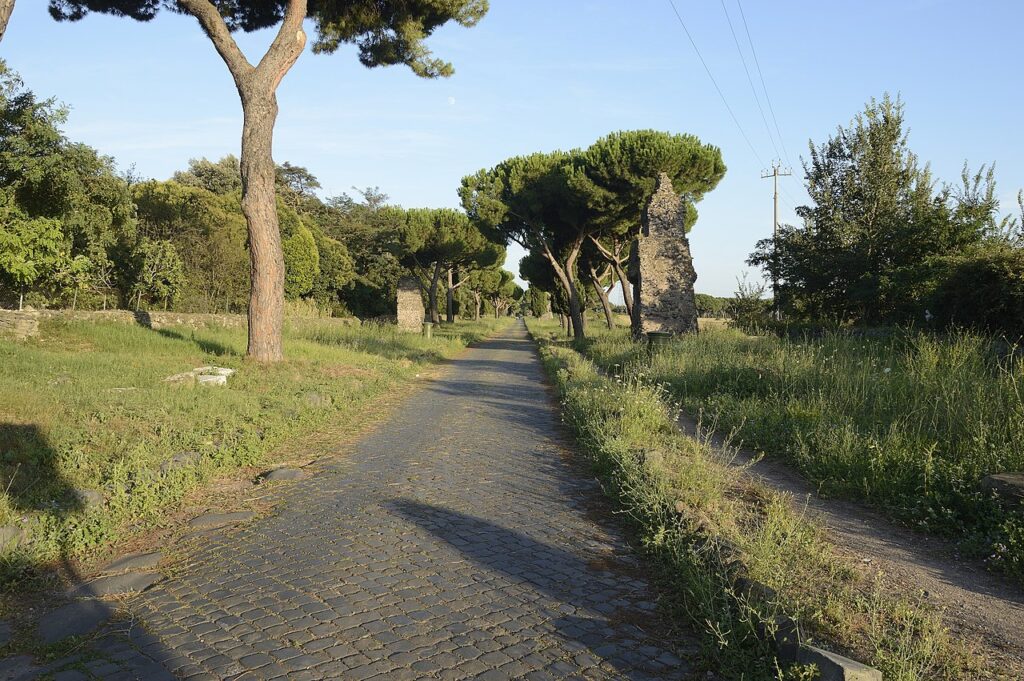John Keahey’s Following Caesar is a riveting journey following three ancient roads and covering more than two thousand years of Ancient Roman history through the modern eye. In the following excerpt, Keahey introduces the Via Appia, a road that’s importance is still felt thousands of years after its inception.

It begins like most things: there is a need or a sense of preservation or, simply put, cold ambition takes over and cannot be squelched. The people who became Romans, traditionally in the eighth century b.c., were first interested only in preserving their hilltops. Then, over a few hundred years, as their wooden and stone huts evolved into humble brick structures and then into columned superstructures, they climbed down those slopes, comingled with other nearby hilltop dwellers, and, after the rule of at least four kings, created a republic.
From that republic’s earliest years, Romans elected consuls who became military leaders and then began looking beyond their hill-lined valley with the Tiber River running through it. There were other people—some friendly and some not so—elsewhere in this hinterland beyond that famous river that was named after a mythical river-god of the earliest Romans, Tiberinus. This waterway, the second-longest on the Italian Peninsula, was a natural transportation route that also provided a line where foes squared off on opposite banks, battling for control of rudimentary bridges. To keep from being taken over, Romans had to build, over time, successive walls, ever-expanding their city outward and absorbing those cross-river rivals. Eventually, early Roman soldiers—cobbled together in rough, barely organized gangs—needed to look beyond their river valley to protect their still-small city from interlopers.
The most critical threat, once the Latins absorbed neighboring Etruscans into their society and subdued local populations, was a people to the south and east known as Samnites, who occupied Italy’s central highlands, which are now part of Italy’s Campania region. For a half-century, from 341 to 290 b.c., roughly more than two centuries before the birth of Julius Caesar, the Romans fought the Samnites and their allies in three wars.
The first war occurred when the people of Capua, located to the south and east of Rome, appealed to the Romans for help against these powerful invaders. The war ended in a treaty, and Capua was firmly under Roman banners. Then, Rome created colonies in Samnite territory, initiating a second war in which Romans lost critical battles before reversing their fortunes and securing another treaty. In this struggle, Rome learned valuable lessons in military organization and tactics from the well-armed Samnites. It adopted a warrior philosophy that served it through its republican years and well into the empire.
Of course, a third war was inevitable. A much-improved and better-disciplined Roman army defeated Samnites, Umbrians, and Etruscans in a battle in Central Italy, followed, in 291 b.c., by a Roman victory over the Samnites in Aquilonia, a town still using that ancient name, and established the colony of Venusia, today’s Venosa, which figures later in our story. Again, a treaty. This time, Rome, still fated to fight other battles on the peninsula against a variety of different peoples in its efforts to unify Italy, emerged as a dominant player.
The Samnite wars are critical to understanding why Roman roads such as the Via Appia and the Via Egnatia to the east of the peninsula became so important in the thousand-year history of the republic-turned-empire. It was during this multilayered conflict that one of the earliest roads and certainly the most famous, the Via Appia, emerged. And while figuring mightily in defeating the Samnites, its success eventually spawned a series of roads all over Europe, North Africa, east to the Black Sea, and into the Middle East. And they all led to Rome.
Appius Claudius Caecus enters our story principally during the Second Samnite War. A writer and political leader, he had to put in time as a military tribune if he wanted to be elected consul. That conflict gave him such a moment. Can we imagine him perhaps ensconced in his tent near a potential battlefield wondering how a large army can make its way through a nearly roadless, muddy environment, hacking through forests, moving quickly with enough supplies to last it through a long march and major battles and to allow reserves to arrive in the nick of time?
No matter how the idea popped into his head, Appius saw the need for a mostly level, mostly straight road that allowed heavy traffic to move perhaps twenty-five miles a day. Such a road would be hewn from volcanic stones hard enough to keep armies, wagons, and horses out of the mud and to quickly meet and engage an enemy. Some Romans opposed it. They worried that the enemy could use such a road to do the same to them. But Appius, newly appointed censor beginning in 312 b.c., got its first segment built within five years and lived long enough to see it extended all the way to friendly Capua, some 130 miles from Rome, by 307 b.c.
It began somewhere near the entrance to the Roman Forum, across from the spot where the Colosseum was built a few hundred years later. The exact spot of its actual beginning could be beneath a nearby roundabout. An article in National Geographic reports that to discover its beginning, “the Ministry of Cultural Heritage has been digging out small, deep strips of pavement—so far, unsuccessfully.”
At any rate, it moved from the Forum area, mostly in a straight line, to the faraway village of Anxur, now known as Terracina. From there, it shifted slightly inland to a place called Fondi, then headed back toward the coast passing through Itri, and, after a stretch along the Mediterranean, it turned southeastward to inland Capua. The name of Itri, a village that figures later in this story, could have been derived from the Latin word iter, which means “route” or “way,” appropriate because the early Via Appia, its ancient stones covered by modern pavement, still flows through its historic center.
Within another half century, with the Samnites out of the picture, the Via Appia—referred to as Regina Viarum or Queen of Roads—was pushed to Beneventum, Venusia, Tarentum, and on to the port city of Brundisium, arriving there about 191 b.c. These places, with the Via Appia’s stones still under modern roads, and often below farmers’ fields, live on today as Benevento, Venosa, Taranto, and Brindisi.

Some researchers, studying how surveyors got the Via Appia so straight from south of Rome to Terracina, believe the ancients, by sighting on certain stars like the divine twins Castor and Pollux to lay out portions of the route, wanted to appease gods who were considered allies. Such a function would be important for a military made up of true believers. Real or not, the researchers have surveyed the route based on star alignments that were present in the skies above south-central Italy two thousand years ago. Castor and Pollux do figure into it. It is up to conjecture whether the religious aspect was mentioned strictly to motivate Roman soldiers who, when not engaged in local battles but still being paid, would be charged with surveying, engineering, stone quarrying, and other hard, physical tasks. Slaves taken from conquered villages along the route could be used, but Roman soldiers did much of the work.
We moderns can imagine how this road looked from viewing photographs of one of the ancient sweeps open to public view. A popular section is a few miles south of the Roman Forum area where modern roads overlie the beginning of that ancient road. This section is preserved in the Parco Regionale dell’Appia Antica, an archaeological park of nearly eighty-five hundred acres and ten miles long. Within it are preserved stretches of original stones glistening in the sunlight with shadows of leaves dancing across their basalt surfaces. That’s the way the road started out in the time of Appius, pushing through the gate of Rome’s early defensive Servian Wall; later another gate for the Aurelian Wall was built over the route.
Copyright © 2023 by John Keahey.

Antonella Siligato
John Keahey, author of such books as Hidden Tuscany and A Sweet and Glorious Land: Revisiting the Ionian Sea, is a veteran newspaper and wire-service journalist who spent forty-five years in and around journalism. He retired in 2011 after twenty-two years, as a reporter and news editor for The Salt Lake Tribune. He has a history degree from the University of Utah and spends as much time as possible in Italy.
